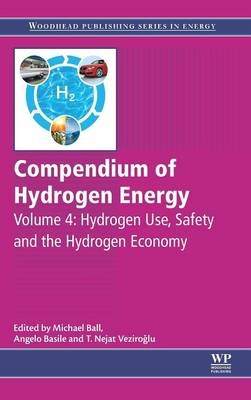
Compendium of Hydrogen Energy
Woodhead Publishing Ltd (Verlag)
978-1-78242-364-5 (ISBN)
Angelo Basile, a Chemical Engineer, is a senior Researcher at the ITM-CNR, University of Calabria, where he is responsible for research related to both the ultra-pure hydrogen production and CO2 capture using Pd-based Membrane Reactors. Angelo Basile's h-index is 53, with 387 document results with a total of 8,910 citations in 5,034 documents (www.scopus.com – 24 May 2023). He has more than 170 scientific papers in peer-to-peer journals and 252 papers in international congresses; and is a reviewer for 165 int. journals, an editor/author of more than 50 scientific books and 120 chapters on international books on membrane science and technology; 6 Italian patents, 2 European patents and 5 worldwide patents. He is referee of 104 international scientific journals and Member of the Editorial Board of 22 of them. Basile is also Editor associate of the Int. J. Hydrogen Energy and Editor-in-chief of the Int. J. Membrane Science & Technol. and Editor-in-chief of Membrane Processes (Applications), a section of the Intl J. Membranes. Basile also prepared 42 special issues on membrane science and technology for many international journals (IJHE, Chem Eng. J., Cat. Today, etc.). He participated to and was/is responsible of many national and international projects on membrane reactors and membrane science. Basile served as Director of the ITM-CNR during the period Dec. 2008 – May 2009. In the last years, he was tutor of 30 Thesis for master and Ph.D. students at the Chemical Engineering Department of the University of Calabria (Italy). From 2014, Basile is Full Professor of Chemical Engineering Processes. Dr. Veziroglu, a native of Turkey, graduated from the City and Guilds College, the Imperial College of Science and Technology, University of London, with degrees in Mechanical Engineering (A.C.G.I., B.Sc.), Advanced Studies in Engineering (D.I.C.) and Heat Transfer (Ph.D.). In 1962 – after doing his military service in the Ordnance Section, serving in some Turkish government agencies and heading a private company – Dr. Veziroglu joined the University of Miami Engineering Faculty. In 1965, he became the Director of Graduate Studies and initiated the first Ph.D. Program in the School of Engineering and Architecture. He served as Chairman of the Department of Mechanical Engineering 1971 through 1975, in 1973 established the Clean Energy Research Institute, and was the Associate Dean for Research 1975 through 1979. He took a three years Leave of Absence (2004 through 2007) and founded UNIDO-ICHET (United Nations Industrial Development Organization – International Centre for Hydrogen Energy Technologies) in Istanbul, Turkey. On 15 May 2009, he attained the status of Professor Emeritus at the University of Miami. Dr. Veziroglu organized the first major conference on Hydrogen Energy: The Hydrogen Economy Miami Energy (THEME) Conference, Miami Beach, 18-20 March 1974. At the opening of this conference, Dr. Veziroglu proposed the Hydrogen Energy System as a permanent solution for the depletion of the fossil fuels and the environmental problems caused by their utilization. Soon after, the International Association for Hydrogen Energy (IAHE) was established, and Dr. Veziroglu was elected president. As President of IAHE, in 1976 he initiated the biennial World Hydrogen Energy Conferences (WHECs), and in 2005 the biennial World Hydrogen Technologies Conventions (WHTCs). In 1976, Dr. Veziroglu started publication of the International Journal of Hydrogen Energy (IJHE) as its Founding Editor-in-Chief, in order to publish and disseminate Hydrogen Energy related research and development results from around the world. IJHE has continuously grew; now it publishes twenty-four issues a year. He has published some 350 papers and scientific reports, edited 160 volumes of books and proceedings, and has co-authored the book “Solar Hydrogen Energy: The Power to Save the Earth. Dr. Veziroglu has memberships in eighteen scientific organizations, has been elected to the Grade of Fellow in the British Institution of Mechanical Engineers, American Society of Mechanical Engineers and the American Association for the Advancement of Science, and is the Founding President of the International Association for Hydrogen Energy. Dr. Veziroglu has been the recipient of several international awards. He was presented the Turkish Presidential Science Award in 1974, made an Honorary Professor in Xian Jiaotong University of China in 1981, awarded the I. V. Kurchatov Medal by the Kurchatov Institute of Atomic Energy of U.S.S.R. in 1982, the Energy for Mankind Award by the Global Energy Society in 1986, and elected to the Argentinean Academy of Sciences in 1988. In 2000, he was nominated for Nobel Prize in Economics, for conceiving the Hydrogen Economy and striving towards its establishment.
List of contributors
Part One: Hydrogen applications in transport and industry
1: Hydrogen-fueled road automobiles – Passenger cars and buses
Abstract
1.1 Introduction
1.2 Comparison of different hydrogen-fueled drive systems
1.3 Technical solutions for FCEVs
1.4 Technical approaches for the main components of FCEVs
1.5 Challenges for FCEVs – Consideration of main markets
1.6 Summary and future trends
1.7 Sources of further information and advice
2: Hydrogen-fueled motorcycles, bicycles, and industrial trucks
Abstract
2.1 Introduction
2.2 Hydrogen motorcycles and bicycles
2.3 Hydrogen industrial trucks
2.4 Conclusions
3: Hydrogen-fueled marine transportation
Abstract
3.1 Market environment
3.2 Requirements for marine FCs
3.3 Suitable FC systems
3.4 FC integration in ships
3.5 Marine FC projects
3.6 Future trends
4: Hydrogen-fueled aeroplanes
Abstract
4.1 Introduction to hydrogen vs. traditional technologies: Differences and similarities, advantages, and disadvantages
4.2 Hydrogen fuel on aircraft—Challenges and requirements
4.3 Advantages and disadvantages of hydrogen storage methods in aeronautics
4.4 Available energy conversion technologies
4.5 Available infrastructure (production, airport)
4.6 Operational aspects (turn around)
4.7 Safety aspects (layout, design, and strategy)
4.8 Safety strategy
4.9 Certification aspects
4.10 Environmental and economic aspects and public acceptance
4.11 Future trends
4.12 Summary
5: Hydrogen-fueled spacecraft and other space applications of hydrogen
Abstract
5.1 Introduction: The potential of hydrogen-powered spacecraft
5.2 Advantages and disadvantages of hydrogen-fueled spacecraft
5.3 Principles: Suitable hydrogen power sources for spacecraft
5.4 Advantages and disadvantages of the power sources
5.5 Challenges for hydrogen-fueled spacecraft
5.6 Other space applications of hydrogen
5.7 Market trends
5.8 Hydrogen storage in spacecraft
5.9 Advantages and disadvantages of the various potential storage methods
5.10 Safety concerns regarding the storage of hydrogen in these vehicles
5.11 Future trends
Part Two: Other applications of hydrogen
6: Hydrogen fuel cells for portable applications
Abstract
Acknowledgments
6.1 Introduction
6.2 Drawbacks of hydrogen fuel cells regarding application in portable devices
6.3 Present status
6.4 Market penetration
6.5 Future perspectives and conclusion
7: Large-scale underground storage of hydrogen for the grid integration of renewable energy and other applications
Abstract
7.1 Hydrogen and the need for energy storage in Europe
7.2 Markets for hydrogen
7.3 Technology for large-scale hydrogen storage
7.4 Potential for hydrogen underground storage
7.5 Hydrogen storage economics in energy systems with increasing share of intermittent renewable energy
7.6 State-of-discussion and development perspectives
8: Hydrogen admixture to the natural gas grid
Abstract
Acknowledgments
8.1 Introduction
8.2 Reasons for adding hydrogen to the natural gas grid
8.3 Potential benefits and problems associated with adding hydrogen to the natural gas grid
8.4 State of the art
8.5 The bottlenecks—Considering a 10 vol% admixture
8.6 R&D necessary to overcome the bottlenecks
8.7 Additional requirements
8.8 Key technologies
8.9 Future trends: The methanation option
8.10 Economic considerations
8.11 Regulatory issues
8.12 Practical recommendations for hydrogen injection
8.13 Conclusions
8.14 Sources of further information
Recommended further reading
Part Three: Hydrogen safety
9: Hydrogen safety: An overview
Abstract
9.1 Introduction
9.2 Properties of hydrogen and their implications for safety
9.3 Hazards of hydrogen
9.4 Management for accident prevention
9.5 Future trends
9.6 Conclusions
9.7 Sources of further information
10: Hydrogen sensors and detectors
Abstract
10.1 Introduction
10.2 Terms and definitions
10.3 Requirements of hydrogen sensors and detectors
10.4 Current hydrogen sensors and detectors on the market: Technologies and operation principles
10.5 Current research and development in hydrogen sensors and detectors
10.6 Detection layout and maintenance of detectors
10.7 Conclusions
10.8 Sources of further information
Part Four: The hydrogen economy
11: The hydrogen economy—Vision or reality?
Abstract
Acknowledgments
11.1 Setting the context—The global energy challenge
11.2 Options for the road transport sector
11.3 A short history of hydrogen
11.4 The status of hydrogen fuel cell vehicles
11.5 Building a hydrogen delivery infrastructure for the transport sector
11.6 The hydrogen infrastructure challenge and how to overcome it
11.7 The role of hydrogen for renewables’ integration
11.8 Perspectives and outlook
12: Building a hydrogen infrastructure in the EU
Abstract
12.1 Introduction: which hydrogen infrastructure(s) is/are required?
12.2 Current status of hydrogen infrastructure
12.3 Costs for setting up the hydrogen infrastructure
12.4 Status and outlook of EU hydrogen infrastructure initiatives
12.5 Moving toward full deployment
12.6 Conclusions
13: Building a hydrogen infrastructure in the United States
Abstract
13.1 Introduction
13.2 Current status of hydrogen infrastructure in the United States
13.3 Initial costs of deploying hydrogen infrastructure
13.4 Market trends
13.5 Hydrogen refueling infrastructure
13.6 Hydrogen production, transmission, and distribution
13.7 Hydrogen transmission and distribution barriers
13.8 Material
14: Building a hydrogen infrastructure in Japan
Abstract
14.1 Introduction
14.2 The new strategic energy plan (Strategic Energy Plan, 2014)
14.3 Strategic Road Map For Hydrogen and FCs (Strategic Road Map for Hydrogen et al., 2014)
14.4 Off-site (centralized) versus on-site (distributed) hydrogen production
14.5 Novel hydrogen production methods
14.6 Hydrogen distribution and storage
14.7 Initial current cost of hydrogen stations
14.8 Residential use FC system (The Japan Gas Association, n.d.)
14.9 FC vehicle
14.10 Current situation in Japan as regards hydrogen infrastructure
14.11 Conclusions
15: Environmental impacts of hydrogen use in vehicles
Abstract
15.1 Introduction
15.2 Environmental assessment
15.3 Reference systems
15.4 Results and discussion
15.5 Final considerations
Index
| Reihe/Serie | Woodhead Publishing Series in Energy |
|---|---|
| Verlagsort | Cambridge |
| Sprache | englisch |
| Maße | 152 x 229 mm |
| Gewicht | 530 g |
| Themenwelt | Naturwissenschaften ► Physik / Astronomie |
| Technik ► Elektrotechnik / Energietechnik | |
| ISBN-10 | 1-78242-364-8 / 1782423648 |
| ISBN-13 | 978-1-78242-364-5 / 9781782423645 |
| Zustand | Neuware |
| Haben Sie eine Frage zum Produkt? |
aus dem Bereich


